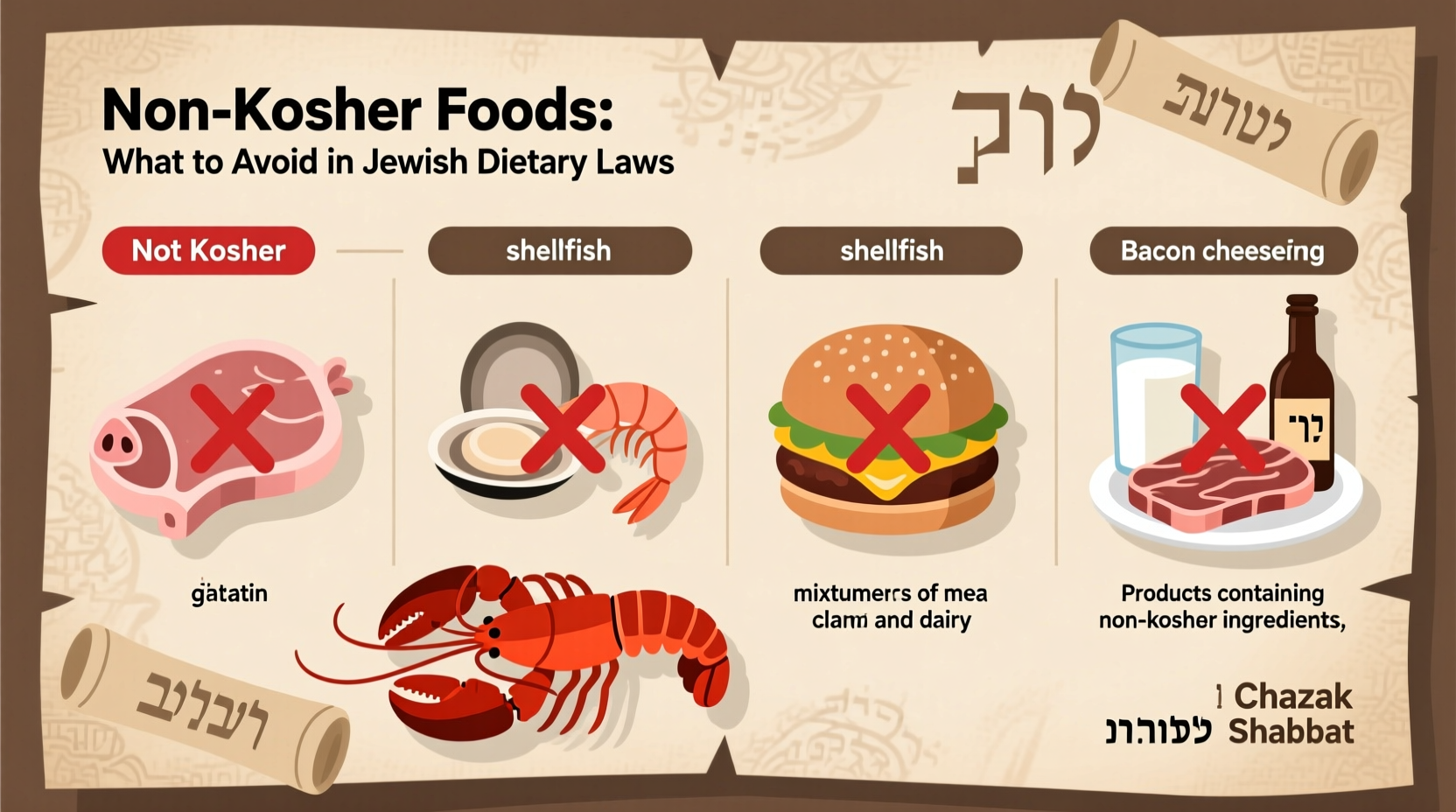The most essential non-kosher foods include pork and all pig products, shellfish (shrimp, lobster, crab, clams), any meat not slaughtered according to shechita (Jewish ritual slaughter), all insects except specific kosher locust varieties, and any mixture of meat and dairy products. These prohibitions derive from Leviticus 11 and Deuteronomy 14 in the Torah, forming the foundation of kashrut (Jewish dietary laws) observed by millions worldwide.
Understanding which foods are not kosher is essential for anyone following Jewish dietary laws or preparing meals for those who do. Kosher certification isn't just about religious compliance—it represents a comprehensive food safety and quality standard recognized globally. Whether you're converting to Judaism, attending a kosher event, or simply curious about these ancient dietary guidelines, knowing the specific foods prohibited under kashrut is your first step toward compliance.
Core Principles Behind Kosher Food Restrictions
Kashrut, the body of Jewish law dealing with permissible foods, originates from biblical commandments in Leviticus 11 and Deuteronomy 14. These laws categorize foods as either kosher (fit or proper) or treif (torn, meaning non-kosher). The determination isn't arbitrary but follows specific criteria that have been interpreted and applied through centuries of rabbinic scholarship.
Three fundamental principles govern kosher food:
- Permitted animal species - Only animals meeting specific biological criteria are allowed
- Proper slaughter method - Shechita, performed by a trained shochet
- Blood removal - Complete draining of blood through salting or broiling
Major Categories of Non-Kosher Foods
Forbidden Animal Species
Not all animals qualify as kosher. The Torah specifies precise biological markers that determine permissibility:
| Kosher Criteria | Kosher Examples | Non-Kosher Examples |
|---|---|---|
| Land animals must have split hooves AND chew cud | Cow, sheep, goat, deer | Pig (split hooves but doesn't chew cud), rabbit (chews cud but no split hooves) |
| Aquatic creatures must have fins AND scales | Salmon, tuna, carp | Shrimp, lobster, crab, eel, catfish, squid |
| Birds must not be on the forbidden species list | Chicken, turkey, duck, goose | Eagle, vulture, owl, ostrich |
This biological specificity explains why pork is universally prohibited in kosher diets—pigs have split hooves but don't chew cud. Similarly, shellfish lack both fins and scales, placing them firmly in the non-kosher category regardless of preparation method.

Meat and Dairy Mixtures
One of the most well-known kosher restrictions prohibits mixing meat and dairy products. This prohibition extends beyond simple combinations to encompass:
- Consuming meat and dairy in the same meal
- Using the same utensils, cookware, or dishes for both categories
- Eating dairy immediately after meat (waiting periods range from 1-6 hours depending on tradition)
This separation stems from the biblical commandment "You shall not boil a kid in its mother's milk" (Exodus 23:19), which rabbinic tradition interprets as a complete prohibition against mixing meat and dairy in any form.
Foods Containing Blood
All blood must be removed from meat before consumption. This requirement comes from Leviticus 7:26-27: "You must not eat any blood, either of bird or of animal, in any of your dwelling places." The koshering process involves:
- Soaking - Meat submerged in water for 30 minutes
- Salting - Coarse salt applied to draw out blood
- Rinsing - Thorough washing to remove salt and extracted blood
Without this process, even otherwise kosher meat remains non-kosher. Liver requires special broiling rather than salting due to its high blood content.
Processing Requirements That Make Foods Non-Kosher
Certification Necessity for Processed Foods
Many seemingly innocuous foods become non-kosher through processing:
- Gelatin - Often derived from non-kosher animal sources
- Enzymes - Used in cheese production may come from non-kosher animals
- Fish eggs - Caviar requires kosher supervision
- Wine and grape products - Must be produced exclusively by Jews
According to the Orthodox Union, over 60% of packaged foods in American supermarkets contain ingredients requiring kosher certification. Even products like ice cream, marshmallows, and chewing gum often contain non-kosher derivatives.
Equipment Cross-Contamination
Foods can become non-kosher through contact with non-kosher equipment. The Talmudic principle of nat bar nat (a secondary flavor transfer) generally permits foods processed on equipment previously used for non-kosher items, but many kosher authorities require dedicated equipment for strict kosher compliance.
Common Misconceptions About Non-Kosher Foods
"All Seafood is Non-Kosher" Myth
Many believe all seafood is prohibited, but only creatures lacking both fins and scales are non-kosher. Salmon, tuna, and carp—all possessing fins and scales—are fully kosher when properly prepared. The misconception likely stems from the prominence of shellfish prohibitions in kosher discussions.
"Kosher Just Means Slaughtered Correctly" Misunderstanding
Proper slaughter (shechita) is essential but represents only one component of kashrut. An animal slaughtered correctly remains non-kosher if it had a pre-existing condition (treifah) like lung adhesions, or if blood isn't properly removed. Kosher certification examines the entire production chain.
Practical Guidance for Identifying Non-Kosher Foods
Reading Labels Effectively
Look for reliable kosher certification symbols rather than ingredient lists alone. The most widely recognized symbols include:
- OU - Orthodox Union (most common in North America)
- Kof-K - Strict Orthodox certification
- Star-K - Baltimore-based certification agency
- OK - OK Kosher Certification
The Chicago Rabbinical Council notes that over 1 million products worldwide carry kosher certification, with the industry growing at 15% annually as consumers recognize kosher standards for quality and safety.
Dining Out Safely
When eating at restaurants:
- Verify kosher certification applies to the entire establishment, not just specific items
- Ask about separate meat/dairy equipment if certification seems questionable
- Be cautious with fish restaurants—many use non-kosher equipment for all seafood
- Remember that "glatt kosher" refers to specific standards for meat, not overall restaurant certification
Special Cases and Exceptions
Medicinal Exceptions
Jewish law permits non-kosher medications when health is at risk. The principle of pikuach nefesh (saving a life) overrides almost all religious restrictions. However, if equally effective kosher alternatives exist, they should be used.
Passover Considerations
During Passover, additional restrictions apply. Foods containing leavened grain products (chametz) become non-kosher for Passover, including many standard kosher products. Special Passover certification (kosher for Passover) is required for grains, flours, and processed foods.
Evolution of Kosher Certification Standards
The modern kosher certification system has evolved significantly:
- Pre-1900s: Local rabbis supervised community butchers and markets
- Early 1900s: Industrial food production created need for standardized certification
- 1923: Orthodox Union established first national kosher certification program
- 1970s: Kosher certification expanded to processed foods and international supply chains
- Today: Digital verification systems and blockchain technology enhance traceability
This evolution reflects how kosher standards have adapted to modern food production while maintaining ancient principles. According to the Kosher Supervision of America, approximately 40% of all packaged foods in the United States now carry some form of kosher certification.
Practical Takeaways for Daily Life
Whether you're new to kosher observance or cooking for someone who keeps kosher, focus on these practical steps:
- Start with basic kitchen separation: designate separate sets of dishes, utensils, and cookware for meat and dairy
- Learn to recognize major kosher certification symbols
- When in doubt about a product, contact the certifying agency directly
- Understand that fresh fruits and vegetables are inherently kosher (though require insect checking)
- Remember that kosher isn't about the food itself but the process and preparation
Following kosher dietary laws connects modern Jews to centuries of tradition while promoting mindfulness about food consumption. As Rabbi Moses Maimonides wrote in the 12th century, these laws serve "to elevate the soul and refine character"—a perspective that continues to resonate with kosher observers today.











 浙公网安备
33010002000092号
浙公网安备
33010002000092号 浙B2-20120091-4
浙B2-20120091-4